+ Open data
Open data
- Basic information
Basic information
| Entry | Database: PDB / ID: 6nt3 | |||||||||||||||||||||||||||||||||||||||||||||||||||||||||||||||||||||||||||||||||||||||||||||||||||||||||||||||||||||||||||||||||||||||||||||||||||||||||||||||
|---|---|---|---|---|---|---|---|---|---|---|---|---|---|---|---|---|---|---|---|---|---|---|---|---|---|---|---|---|---|---|---|---|---|---|---|---|---|---|---|---|---|---|---|---|---|---|---|---|---|---|---|---|---|---|---|---|---|---|---|---|---|---|---|---|---|---|---|---|---|---|---|---|---|---|---|---|---|---|---|---|---|---|---|---|---|---|---|---|---|---|---|---|---|---|---|---|---|---|---|---|---|---|---|---|---|---|---|---|---|---|---|---|---|---|---|---|---|---|---|---|---|---|---|---|---|---|---|---|---|---|---|---|---|---|---|---|---|---|---|---|---|---|---|---|---|---|---|---|---|---|---|---|---|---|---|---|---|---|---|---|
| Title | Cryo-EM structure of a human-cockroach hybrid Nav channel. | |||||||||||||||||||||||||||||||||||||||||||||||||||||||||||||||||||||||||||||||||||||||||||||||||||||||||||||||||||||||||||||||||||||||||||||||||||||||||||||||
 Components Components | Sodium channel protein type 9 subunit alpha, Sodium channel protein PaFPC1, chimeric construct | |||||||||||||||||||||||||||||||||||||||||||||||||||||||||||||||||||||||||||||||||||||||||||||||||||||||||||||||||||||||||||||||||||||||||||||||||||||||||||||||
 Keywords Keywords | MEMBRANE PROTEIN / Sodium channel / scorpion toxin / electrical signaling / fast inactivation | |||||||||||||||||||||||||||||||||||||||||||||||||||||||||||||||||||||||||||||||||||||||||||||||||||||||||||||||||||||||||||||||||||||||||||||||||||||||||||||||
| Function / homology |  Function and homology information Function and homology informationaction potential propagation / detection of mechanical stimulus involved in sensory perception / membrane depolarization during action potential / cardiac muscle cell action potential involved in contraction / node of Ranvier / voltage-gated sodium channel complex / voltage-gated monoatomic cation channel activity / Interaction between L1 and Ankyrins / voltage-gated sodium channel activity / detection of temperature stimulus involved in sensory perception of pain ...action potential propagation / detection of mechanical stimulus involved in sensory perception / membrane depolarization during action potential / cardiac muscle cell action potential involved in contraction / node of Ranvier / voltage-gated sodium channel complex / voltage-gated monoatomic cation channel activity / Interaction between L1 and Ankyrins / voltage-gated sodium channel activity / detection of temperature stimulus involved in sensory perception of pain / Phase 0 - rapid depolarisation / behavioral response to pain / neuronal action potential / axon terminus / sensory perception of pain / sodium ion transmembrane transport / post-embryonic development / circadian rhythm / response to toxic substance / Sensory perception of sweet, bitter, and umami (glutamate) taste / inflammatory response / axon / plasma membrane Similarity search - Function | |||||||||||||||||||||||||||||||||||||||||||||||||||||||||||||||||||||||||||||||||||||||||||||||||||||||||||||||||||||||||||||||||||||||||||||||||||||||||||||||
| Biological species |  Periplaneta americana (American cockroach) Periplaneta americana (American cockroach) Homo sapiens (human) Homo sapiens (human) | |||||||||||||||||||||||||||||||||||||||||||||||||||||||||||||||||||||||||||||||||||||||||||||||||||||||||||||||||||||||||||||||||||||||||||||||||||||||||||||||
| Method | ELECTRON MICROSCOPY / single particle reconstruction / cryo EM / Resolution: 3.4 Å | |||||||||||||||||||||||||||||||||||||||||||||||||||||||||||||||||||||||||||||||||||||||||||||||||||||||||||||||||||||||||||||||||||||||||||||||||||||||||||||||
 Authors Authors | Clairfeuille, T. / Rohou, A. / Payandeh, J. | |||||||||||||||||||||||||||||||||||||||||||||||||||||||||||||||||||||||||||||||||||||||||||||||||||||||||||||||||||||||||||||||||||||||||||||||||||||||||||||||
 Citation Citation |  Journal: Science / Year: 2019 Journal: Science / Year: 2019Title: Structural basis of α-scorpion toxin action on Na channels. Authors: Thomas Clairfeuille / Alexander Cloake / Daniel T Infield / José P Llongueras / Christopher P Arthur / Zhong Rong Li / Yuwen Jian / Marie-France Martin-Eauclaire / Pierre E Bougis / Claudio ...Authors: Thomas Clairfeuille / Alexander Cloake / Daniel T Infield / José P Llongueras / Christopher P Arthur / Zhong Rong Li / Yuwen Jian / Marie-France Martin-Eauclaire / Pierre E Bougis / Claudio Ciferri / Christopher A Ahern / Frank Bosmans / David H Hackos / Alexis Rohou / Jian Payandeh /     Abstract: Fast inactivation of voltage-gated sodium (Na) channels is essential for electrical signaling, but its mechanism remains poorly understood. Here we determined the structures of a eukaryotic Na ...Fast inactivation of voltage-gated sodium (Na) channels is essential for electrical signaling, but its mechanism remains poorly understood. Here we determined the structures of a eukaryotic Na channel alone and in complex with a lethal α-scorpion toxin, AaH2, by electron microscopy, both at 3.5-angstrom resolution. AaH2 wedges into voltage-sensing domain IV (VSD4) to impede fast activation by trapping a deactivated state in which gating charge interactions bridge to the acidic intracellular carboxyl-terminal domain. In the absence of AaH2, the S4 helix of VSD4 undergoes a ~13-angstrom translation to unlatch the intracellular fast-inactivation gating machinery. Highlighting the polypharmacology of α-scorpion toxins, AaH2 also targets an unanticipated receptor site on VSD1 and a pore glycan adjacent to VSD4. Overall, this work provides key insights into fast inactivation, electromechanical coupling, and pathogenic mutations in Na channels. | |||||||||||||||||||||||||||||||||||||||||||||||||||||||||||||||||||||||||||||||||||||||||||||||||||||||||||||||||||||||||||||||||||||||||||||||||||||||||||||||
| History |
|
- Structure visualization
Structure visualization
| Movie |
 Movie viewer Movie viewer |
|---|---|
| Structure viewer | Molecule:  Molmil Molmil Jmol/JSmol Jmol/JSmol |
- Downloads & links
Downloads & links
- Download
Download
| PDBx/mmCIF format |  6nt3.cif.gz 6nt3.cif.gz | 270.6 KB | Display |  PDBx/mmCIF format PDBx/mmCIF format |
|---|---|---|---|---|
| PDB format |  pdb6nt3.ent.gz pdb6nt3.ent.gz | 204.5 KB | Display |  PDB format PDB format |
| PDBx/mmJSON format |  6nt3.json.gz 6nt3.json.gz | Tree view |  PDBx/mmJSON format PDBx/mmJSON format | |
| Others |  Other downloads Other downloads |
-Validation report
| Summary document |  6nt3_validation.pdf.gz 6nt3_validation.pdf.gz | 1.8 MB | Display |  wwPDB validaton report wwPDB validaton report |
|---|---|---|---|---|
| Full document |  6nt3_full_validation.pdf.gz 6nt3_full_validation.pdf.gz | 1.8 MB | Display | |
| Data in XML |  6nt3_validation.xml.gz 6nt3_validation.xml.gz | 55.7 KB | Display | |
| Data in CIF |  6nt3_validation.cif.gz 6nt3_validation.cif.gz | 81.1 KB | Display | |
| Arichive directory |  https://data.pdbj.org/pub/pdb/validation_reports/nt/6nt3 https://data.pdbj.org/pub/pdb/validation_reports/nt/6nt3 ftp://data.pdbj.org/pub/pdb/validation_reports/nt/6nt3 ftp://data.pdbj.org/pub/pdb/validation_reports/nt/6nt3 | HTTPS FTP |
-Related structure data
| Related structure data |  0500MC  0501C  6nt4C M: map data used to model this data C: citing same article ( |
|---|---|
| Similar structure data |
- Links
Links
- Assembly
Assembly
| Deposited unit | 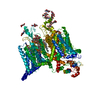
|
|---|---|
| 1 |
|
- Components
Components
-Protein , 1 types, 1 molecules A
| #1: Protein | Mass: 178763.656 Da / Num. of mol.: 1 Source method: isolated from a genetically manipulated source Source: (gene. exp.)  Periplaneta americana (American cockroach), (gene. exp.) Periplaneta americana (American cockroach), (gene. exp.)  Homo sapiens (human) Homo sapiens (human)Gene: SCN9A, NENA / Cell line (production host): Expi293 / Production host:  Homo sapiens (human) / References: UniProt: D0E0C2, UniProt: Q15858 Homo sapiens (human) / References: UniProt: D0E0C2, UniProt: Q15858 |
|---|
-Sugars , 3 types, 7 molecules 
| #2: Polysaccharide | beta-D-mannopyranose-(1-3)-[beta-D-mannopyranose-(1-6)]beta-D-mannopyranose-(1-3)-2-acetamido-2- ...beta-D-mannopyranose-(1-3)-[beta-D-mannopyranose-(1-6)]beta-D-mannopyranose-(1-3)-2-acetamido-2-deoxy-beta-D-glucopyranose-(1-3)-2-acetamido-2-deoxy-beta-D-glucopyranose Source method: isolated from a genetically manipulated source | ||
|---|---|---|---|
| #3: Polysaccharide | Source method: isolated from a genetically manipulated source #4: Sugar | ChemComp-NAG / |
-Non-polymers , 4 types, 7 molecules 
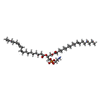

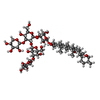



| #5: Chemical | ChemComp-Y01 / | ||||
|---|---|---|---|---|---|
| #6: Chemical | ChemComp-76F / ( #7: Chemical | ChemComp-LHG / | #8: Chemical | ChemComp-AJP / | |
-Details
| Has protein modification | Y |
|---|
-Experimental details
-Experiment
| Experiment | Method: ELECTRON MICROSCOPY |
|---|---|
| EM experiment | Aggregation state: PARTICLE / 3D reconstruction method: single particle reconstruction |
- Sample preparation
Sample preparation
| Component | Name: NavPas-VSD4 / Type: COMPLEX / Entity ID: #1 / Source: RECOMBINANT |
|---|---|
| Molecular weight | Value: 0.155 MDa / Experimental value: NO |
| Source (natural) | Organism:  Periplaneta americana (American cockroach) Periplaneta americana (American cockroach) |
| Source (recombinant) | Organism:  Homo sapiens (human) / Cell: Expi293 Homo sapiens (human) / Cell: Expi293 |
| Buffer solution | pH: 7.5 |
| Specimen | Conc.: 1.5 mg/ml / Embedding applied: NO / Shadowing applied: NO / Staining applied: NO / Vitrification applied: YES |
| Specimen support | Details: Grids were plasma etched using the Solarus plasma cleaner (Gatan) in the hydrogen-oxygen setting. Grids were etched for 4 minutes on each side to remove burrs from hole edges. The grids were ...Details: Grids were plasma etched using the Solarus plasma cleaner (Gatan) in the hydrogen-oxygen setting. Grids were etched for 4 minutes on each side to remove burrs from hole edges. The grids were then coated on both sides with 5nm of Au/Pd which was plasma deposited using the Leica ACE600 (Leica). Grid material: COPPER / Grid mesh size: 200 divisions/in. / Grid type: C-flat-2/1 |
| Vitrification | Instrument: FEI VITROBOT MARK IV / Cryogen name: ETHANE / Humidity: 100 % / Chamber temperature: 277 K |
- Electron microscopy imaging
Electron microscopy imaging
| Experimental equipment |  Model: Titan Krios / Image courtesy: FEI Company |
|---|---|
| Microscopy | Model: FEI TITAN KRIOS |
| Electron gun | Electron source:  FIELD EMISSION GUN / Accelerating voltage: 300 kV / Illumination mode: FLOOD BEAM FIELD EMISSION GUN / Accelerating voltage: 300 kV / Illumination mode: FLOOD BEAM |
| Electron lens | Mode: BRIGHT FIELD / Cs: 2.7 mm / Alignment procedure: ZEMLIN TABLEAU |
| Specimen holder | Cryogen: NITROGEN / Specimen holder model: FEI TITAN KRIOS AUTOGRID HOLDER |
| Image recording | Average exposure time: 10 sec. / Electron dose: 40 e/Å2 / Detector mode: COUNTING / Film or detector model: GATAN K2 SUMMIT (4k x 4k) / Num. of grids imaged: 1 / Num. of real images: 10421 |
| EM imaging optics | Energyfilter name: GIF Bioquantum / Energyfilter slit width: 20 eV |
| Image scans | Movie frames/image: 40 |
- Processing
Processing
| Software | Name: PHENIX / Version: 1.14_3260: / Classification: refinement | |||||||||||||||||||||||||||
|---|---|---|---|---|---|---|---|---|---|---|---|---|---|---|---|---|---|---|---|---|---|---|---|---|---|---|---|---|
| EM software |
| |||||||||||||||||||||||||||
| CTF correction | Type: PHASE FLIPPING AND AMPLITUDE CORRECTION | |||||||||||||||||||||||||||
| Particle selection | Details: Automated picking using a soft-edged disc as a template yielded 591739 candidate coordinates. 2D classification led to the selection of 334055 particles for further analysis. | |||||||||||||||||||||||||||
| Symmetry | Point symmetry: C1 (asymmetric) | |||||||||||||||||||||||||||
| 3D reconstruction | Resolution: 3.4 Å / Resolution method: FSC 0.143 CUT-OFF / Num. of particles: 150583 / Algorithm: FOURIER SPACE Details: No information from spatial frequencies higher than 1/5A were ever used during refinement. Num. of class averages: 1 / Symmetry type: POINT |
 Movie
Movie Controller
Controller



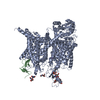
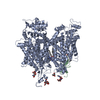
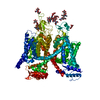
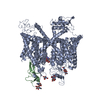
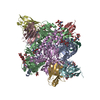
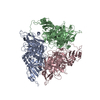
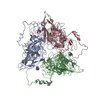
 PDBj
PDBj













